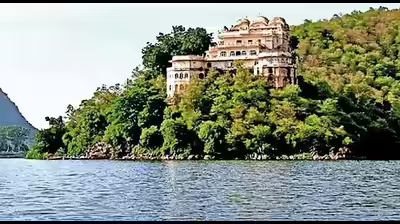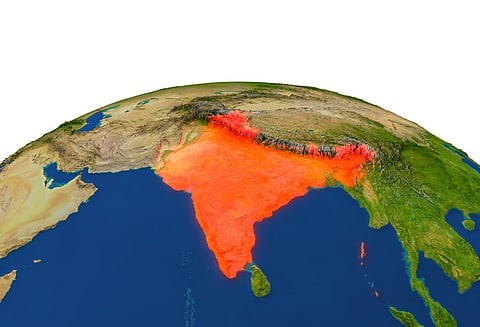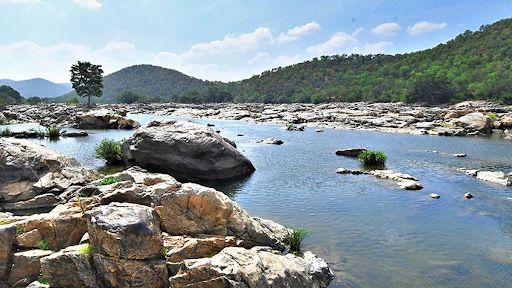




Disclaimer: Copyright infringement not intended.
Tensions rise as Kuki-Zo groups oppose Meitei pilgrimage to sacred Thangjing Hill citing political rights & territorial jurisdiction amid ongoing ethnic discord in Manipur.
|
Category |
Details |
|
Location |
Thangjing Hill, Churachandpur district, Manipur |
|
Significance |
Sacred site for Meiteis; shrine of Ibudhou Thangjing, guardian deity of mountains |
|
Pilgrimage |
Annual pilgrimage by Meiteis in April |
|
Kuki-Zo Objection |
Meiteis allegedly crossing buffer zone into Kuki-Zo dominated areas |
|
Main Concern |
Kuki-Zo demand political settlement before allowing cross-community access |
|
Recent Protest |
Kuki-Zo groups staged demonstration at Thangjing hill opposing Meitei pilgrimage |
|
Political Response |
Former CM Okram Ibobi Singh & AMUCO appealed for peace & protection of pilgrims |
|
Legal Status |
Declared protected under Manipur Ancient Monuments & Archaeological Sites Act, 1976 |
|
Gazette Notification |
Gazette No. 376 dated 14/11/2022 by Government of Manipur |
|
Tension Catalyst |
Perceived territorial encroachment & identity assertion amidst ongoing ethnic violence |
|
Broader Ethnic Context |
Ongoing Kuki-Meitei conflict since 2023 over land rights, reservation & autonomy |
|
Aspect |
Meitei Community |
Kuki-Zo Community |
|
Ethnic Identity |
Predominantly Hindu/Meitei Sanamahi |
Tribal Christian population |
|
Religious Link to Site |
Worship of Ibudhou Thangjing deity |
No religious affiliation with site |
|
Settlement |
Valley dwellers, Imphal-based |
Hill-dwellers, Churachandpur & hill areas |
|
Grievances |
Blockade of pilgrimage to sacred site |
Perceived territorial trespass & political neglect |
|
Legal Provision |
Relevance |
|
Manipur Ancient Monuments Act (1976) |
Thangjing Hill is a protected site under Section 4 |
|
Buffer Zones Post-2023 Clashes |
Zones established between Kuki-Zo & Meitei areas to avoid confrontation |
|
Scheduled Tribe Status Issue |
Meitei demand for ST status is a key trigger in ethnic tension |
|
Dimension |
Impact |
|
Social |
Deepening ethnic rift, risk of violence recurrence |
|
Religious |
Tensions over sacred geography & religious freedoms |
|
Political |
Undermining efforts toward reconciliation & peace in Manipur |
|
Legal |
Conflict between protected status of site vs community territorial claims |
|
Security |
Threat of local clashes; central intervention may be needed to maintain law & order |
|
Feature |
Details |
|
Location |
Churachandpur district, Manipur, India |
|
Coordinates |
Approx. 24.2°N, 93.5°E |
|
Religious Significance |
Sacred hill to Meitei community dedicated to deity Ibudhou Thangjing |
|
Deity Worshipped |
Ibudhou Thangjing considered guardian of hill/mountains |
|
Protected Status |
Declared protected under Manipur Ancient & Historical Monuments Act, 1976 (2022 Gazette) |
|
Ethnic Jurisdiction Claim |
Claimed as Kuki-Zo territorial land by Kuki-Zo community |
|
Cultural Events |
Annual pilgrimage by Meiteis in April |
|
Current Dispute |
Kuki-Zo groups opposing Meitei pilgrimage citing political settlement pending |
|
Strategic Relevance |
Lies near buffer zones between Meitei-dominated valley & Kuki-Zo inhabited hills |
|
River/Stream |
Type |
Flow Direction |
Proximity to Thangjing Hill |
Tribal/Ecological Significance |
|
Tuila River |
Tributary of Khuga River (Tuitha) |
Northward from Churachandpur Hills |
West of Thangjing Hill |
Flows through Kuki-Zo dominated areas; vital for local agriculture; forms part of buffer zone in conflict region. |
|
Leimatak River |
Tributary of Barak River |
South-West to North-East |
Flows along south & southeast of Thangjing Hill |
Runs near hydroelectric projects; source of hydropower & irrigation; sometimes overlaps with Kuki-Meitei administrative borders. |
|
Khuga (Tuitha) River |
Major river in Churachandpur |
South to North |
Southwest of hill |
Major river for Kuki-Zo settlements; used in land demarcations & cultural identity. |
|
Iril River |
Major river |
North-East to South-East |
East of Moirang/Thangjing |
Drains parts of Imphal plain; relevant for water resource planning. |
|
Nambul River |
Tributary of Imphal River |
North to South |
Northeast of hill |
Passes through urban Imphal; links Loktak Lake. |
|
Moirang River |
Local stream/tributary |
Flows into Loktak Lake |
East of Thangjing Hill |
Part of Meitei sacred landscape; supports valley rice cultivation. |
|
Leimatak Hydel Stream |
Controlled stream |
Offshoot of Leimatak River |
Southeast of hill |
Associated with Leimatak Hydro Electric Project in Tamenglong/Churachandpur area. |
|
Loktak Wetland Drainage |
Natural basin |
Collects multiple river flows |
10–15 km from hill |
Includes sacred sites (Sendra, Phumdis), ecologically sensitive area with Meitei-Kuki-Zo links. |
|
Turel (generic) |
Seasonal hill streams |
Varies (monsoon dependent) |
All around Thangjing slopes |
Used in rituals during Lai Haraoba; connected to Meitei animistic traditions. |
|
Aspect |
Details |
|
Full Title |
Ibudhou Thangjing Apokpa (Lord Father Thangjing, Ancestor Deity) |
|
Pantheon |
One of four original Umang Lais (forest deities) of Sanamahism pre-Hindu Meitei religion |
|
Historical Worship Centre |
Moirang an ancient Meitei principality located in present day Bishnupur district Manipur |
|
Sacred Landscape |
Thangjing Hill believed to be deity abode; worship rituals are performed atop hill during annual pilgrimages |
|
Festivals in Honour |
Moirang Lai Haraoba a month-long traditional festival celebrating creation stories & glory of Ibudhou Thangjing |
|
Mythological Role |
Regarded as protector of southern boundary of Ancient Kangleipak; plays a key role in Meitei cosmogony & clan mythology |
|
Symbolism in Sanamahism |
Thangjing represents divine link between land, forest & lineage sacred geography & ancestral power |
|
Oral Traditions & Texts |
Featured prominently in Moirang Kangleirol epic ballads of Moirang including famous love story of Khamba-Thoibi |
|
Ritual Practices |
Includes offerings of rice, fruits, flowers, ritual music using Pena, dances by Maibi priestesses & storytelling ceremonies |
|
Temple Architecture |
Traditional Meitei style with bamboo & wood sometimes laterite; located in isolated natural settings like hilltops |
|
Modern Worship Form |
Revived under Sanamahi resurgence movements resisting homogenisation by Vaishnavism & external cultural influences |
|
Community Role |
Central to cultural revival & ethnic assertion of Meiteis especially in opposition to perceived marginalisation |
|
Sacred Status Declaration |
Recognised under Manipur Ancient & Historical Monuments & Archaeological Sites & Remains Act, 1976 |
|
Contemporary Political Significance |
Site of ethnic-religious conflict between Meiteis & Kuki-Zo as it lies within a buffer zone in Churachandpur district |
|
Contending Narratives |
Meiteis view it as a sacred pilgrimage to a historic deity while Kuki-Zo tribes view it as an intrusion into their ethnic territory |
|
Government Position |
Urged protection of shrine as a cultural asset; political leaders like Okram Ibobi Singh called for peaceful co-existence |
|
NGO Positions |
AMUCO & Meitei Heritage Foundation urge central protection of site citing threats of provocation & desecration |
|
Geospatial Importance |
Located on edge of Churachandpur-Bishnupur boundary within a region highly sensitive due to buffer zones from 2023 ethnic violence |
|
Tourism Potential |
Identified for ethnic heritage tourism by some civil society actors though such plans remain controversial due to community sensitivities |
|
Feature |
Meitei Community |
Kuki-Zo Community |
|
Ethnic Group |
Predominantly Vaishnavite Hindus |
Chin-Kuki-Mizo group (ethnolinguistic cluster) |
|
Language |
Meiteilon (Manipuri) |
Kuki-Chin languages |
|
Geographic Distribution |
Imphal Valley, Manipur |
Hill districts like Churachandpur, Kangpokpi, Pherzawl |
|
Religious Beliefs |
Hinduism (Vaishnavism), Sanamahi religion |
Christianity (Protestant denominations mainly) |
|
Scheduled Tribe Status |
Not classified as ST (demands for inclusion ongoing) |
Classified as Scheduled Tribe |
|
Cultural Institutions |
Lai Haraoba, Ras Lila, traditional dances |
Kuki Harvest Festival, Sielkal Lungphun |
|
Political Demands |
ST status, valley-based dominance |
Separate administration, autonomy, sometimes statehood |
|
Historical Conflicts |
1990s ethnic riots with Nagas & Kukis |
Clashes with Meiteis in 1997, 2023 conflict |
|
Social Organization |
Highly centralized in Imphal |
Village-based chieftain system |
|
Conflict Zone |
Communities Involved |
Root Cause |
Current Demands |
Similarities to Thangjing Case |
|
Thangjing, Manipur |
Meitei vs. Kuki-Zo |
Religious pilgrimage vs. territorial claim |
Political settlement for Kuki-Zo; protection of Meitei pilgrimage |
Ethnic-religious, land rights, state inaction |
|
Bodoland, Assam |
Bodos vs. non-Bodos |
Autonomy, identity, migration issues |
Autonomous Council, sometimes statehood |
Autonomy demand, violent history, tribal land issues |
|
Gorkhaland, WB |
Gorkhas vs. West Bengal govt |
Ethnic identity, linguistic assertion |
Separate state |
Hills vs. plains dynamic, ethnic assertion |
|
Karen Hills, Myanmar |
Karen Christians vs. Myanmar Govt |
Ethnic repression, cultural rights |
Federal autonomy, cultural protection |
Christian-majority hill tribe vs. dominant state |
|
Chittagong Hill Tracts |
Chakmas vs. Bangladesh Govt |
Land rights, Buddhist identity, forced settlement |
Greater autonomy, land restitution |
Hill vs. plain dynamic, Indigenous vs. state issue |
For more information, please refer to IAS GYAN
Sources:
|
PRACTICE QUESTION Q. Ethnic conflicts in North-Eastern states have often revolved around sacred geography, identity & territorial jurisdiction. Examine with reference to Thangjing Hill controversy in Manipur. |






© 2025 iasgyan. All right reserved